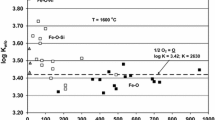Abstract
The\(\mu _{O_2 } \) defined by the reaction 6 MnO+O2 =2 Mn3O4 has been determined from 917 to 1,433 K using electrochemical cells (with calcia-stabilized zirconta, CSZ) of the type:
Steady emfs were achieved rapidly at all temperatures on both increasing and decreasing temperature, indicating that the MnO-Mn3O4 oxygen buffer equilibrates relatively easily. It therefore makes a useful alternative choice in experimental petrology to Fe2O3-Fe3O4 for buffering oxygen potentials at oxidized values. The results are (in J/mol, temperature in K, reference pressure 1 bar);\(\mu _{O_2 } \) (±200)=-563,241+1,761.758T-220.490T inT+0.101819T 2 with an uncertainty of ±200 J/mol. Third law analysis of these data, including a correction for the deviations in stoichiometry of MnO, impliesS 298.15 for Mn3O4 of 166.6 J/K · mol, which is 2.5 J/K · mol higher than the calorimetric determination of Robie and Hemingway (1985). The low value of the calorimetric entropy may be due to incomplete ordering of the magnetic spins. The third law value of Δ r H 0298.15 is-450.09 kJ/mol, which is significantly different from the calorimetric value of-457.5±3.4 kJ/mol, calculated from Δ f H 0298.15 of MnO and Mn3O4, implying a small error in one or both of these latter.
Similar content being viewed by others
References
Alcock CB, Zador S (1967) Thermodynamic study of the manganese/manganese-oxide system by the use of solid electrolytes. Electrochim Acta 12:673–677
Blumenthal RN, Whitmore DH (1961) Electrochemical measurements of elevated-temperature thermodynamic properties of certain iron and manganese oxide mixtures. J Am Ceram Soc 44:508–512
Chardon B, Vigneron F (1986) Mn3O4 commensurate and incommensurate magnetic structures. J Magn Magn Mater 58:128–134
Charette GG, Flengas SN (1968) Thermodynamic properties of the oxides of Fe, Ni, Pb, Cu, and Mn, by EMF measurements. J Electrochem Soc 115:796–804
Chhor K, Bocquet JF, Pommier C (1986) Heat capacity and thermodynamic behaviour of Mn3O4 and ZnMn2O4 at low temperatures. J Chem Thermody 18:89–99
Chou I-M (1978) Calibration of oxygen buffers at elevatedP andT using the hydrogen fugacity sensor. Am Mineral 63:690–703
Franke P, Dieckmann R (1987) Defect structure and transport properties of manganese oxides. III. Relaxation kinetics of manganosite (Mn1–Δ O) in CO/CO2 gas mixtures. Ber Bunsenges Phys Chem 91:49–56
Haas JL Jr, Fisher JR (1976) Simultaneous evaluation and correlation of thermodynamic data. Am J Sci 276:525–545
Hemingway BS (1990) Thermodynamic properties for bunsenite, NiO, magnetite, Fe3O4, and hematite Fe2O3, with comments on selected oxygen buffer reactions. Am Mineral 75:781–790
Huebner JS, Sato M (1970) The oxygen fugacity-temperature relationships of manganese oxide and nickel oxide buffers. Am Mineral 55:934–952
Jarosch D (1987) Crystal structure refinement and reflectance measurements of hausmannite, Mn3O4. Mineral Petrol 37:15–23
Keller M, Dieckmann R (1985a) Defect structure and transport properties of manganese oxides. I. The nonstoichiometry of manganosite (Mn1-ΔO). Ber Bunsenges Phys Chem 89:883–893
Keller M, Dieckmann R (1985b) Defect structure and transport properties of manganese oxides. II. The nonstoichiometry of hausmannite (Mn3-δO4). Ber Bunsenges Phys Chem 89:1095–1104
Keller M, Xue J, Dieckmann R (1991) Electrochemical investigation of the oxygen activity at the manganosite-hausmannite equilibrium. J Electrochem Soc 138:3398–3400
Kim DQ, Wilber Y, Marion F (1966) Sur la détermination directe des équilibres des oxydes de manganèse à haute température. CR Acad Sci Paris, Ser C 262:756–758
Millar RW (1928) The specific heats at low temperatures of manganous oxide, manganous-manganic oxide and manganese dioxide. J Am Chem Soc 50:1875–1883
O'Neill HStC (1987) Free energies of formation of NiO, CoO, Ni2SiO4, and Co2SiO4. Am Mineral 72:280–291
O'Neill HStC (1988) Systems Fe-O and Cu-O: thermodynamic data for the equilibria Fe-“FeO”, Fe-Fe3O4 “FeO”-Fe3O4, Fe3O4-Fe2O3, Cu-Cu2O, and Cu2O-CuO from emf measurements. Am Mineral 73:470–486
O'Neill HStC, Pownceby MI (1993) Thermodynamic data from redox reactions at high temperatures. I. An experimental and theoretical assessment of the electrochemical method using stabilized zirconia electrolytes, with revised values for the Fe-“FeO”, Co-CoO, Ni-NiO and Cu-Cu2O oxygen buffers, and new data for the W-WO2 buffer. Contrib Mineral Petrol 114:296–314
Robie RA, Hemingway BS (1985) Low temperature molar heat capacities and entropies of MnO2 (pyrolusite), Mn3O4 (hausmannite), and Mn2O3 (bixbyite). J Chem Thermodyn 17:165–181
Robie RA, Hemingway BS, Fisher JR (1978) Thermodynamic properties of minerals and related substances at 298.15 K and 1 bar (105 pascals) pressure and at higher temperatures. US Geol Surv Bull 1452
Schaefer SC (1982) Electrochemical determination of thermodynamic properties of manganomanganic oxide and manganese sesquioxide. US Bur Mines Rep Invest 8704
Schwerdtfeger K (1967) Measurement of oxygen activity in iron, iron-silicon, manganese, and iron-manganese melts using solid electrolyte galvanic cells. Trans Metall Soc AIME 239:1276–1281
Schwerdtfeger K, Muan A (1967) Equilibria in the system Fe-Mn-O involving “(Fe,Mn)O” and (Fe, Mn)3O4 solid solutions. Trans Metall Soc AIME 239:1114–1119
Shomate CH (1943) Heats of formation of manganomanganic oxide and manganese dioxide. J Am Chem Soc 65:785–790
Southard JC, Moore GE (1942) High temperature heat contents of Mn3O4, MnSiO3 and Mn3C. J Am Chem Soc 64:1769–1770
Southard JC, Shomate CH (1942) Heat of formation and high temperature heat content of manganous oxide and manganesous sulfate: high temperature heat content of manganese. J Am Chem Soc 64:1770–1774
Steele BCH (1968) High temperature thermodynamic measurements involving solid electrolytes. In: Alcock CB (ed) Electromotive force measurements in high temperature systems. Inst Min Metall, London, pp 3–27
Author information
Authors and Affiliations
Rights and permissions
About this article
Cite this article
O'Neill, H.S.C., Pownceby, M.I. Thermodynamic data from redox reactions at high temperatures. II. The MnO-0Mn3O4 oxygen buffer, and implications for the thermodynamic properties of MnO and Mn3O4 . Contr. Mineral. and Petrol. 114, 315–320 (1993). https://doi.org/10.1007/BF01046534
Received:
Accepted:
Issue Date:
DOI: https://doi.org/10.1007/BF01046534



